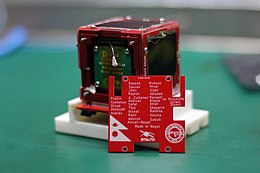cosmos.wikisort.org - Spacecraft
Nepal-PQ1 also known as SanoSat-1 is Nepal's first PocketQube picosatellite developed by ORION Space that was launched on January 13, 2022, from Falcon 9.[1] The primary function of the satellite is to collect wind, temperature, and humidity data and communicate findings with ground stations in Nepal[2][3][4]
 SanoSat-1 with the list of contributors | |
| Mission type | Space Engineering |
|---|---|
| Operator | AMSAT-Nepal |
| COSPAR ID | 2022-002W |
| SATCAT no. | 51004 |
| Spacecraft properties | |
| Manufacturer | ORION Space |
Background
The PocketQube is developed by ORION Space in collaboration with AMSAT-Nepal and AMSAT-EA, with the brokerage service offered by FOSSA Systems, a leading aerospace company focused on developing picosatellites for IoT communications. SanoSat-1 is a PocketQube of 1P size designed and developed with readily available commercial components (COTS) to measure space radiation while orbiting, and periodically transmit it to Earth. The satellite will act as a digital repeater in an amateur band. The store and forward concept can be used in remote disaster-prone locations. The same concept can also be used to collect data from ground-based sensors, store it on board, and transmit it to Earth's main station. The picosatellite has successfully passed all Environmental Testing Campaigns and is on its way to Cape Canaveral (Florida, USA), where it will be launched with SpaceX's Falcon 9 vehicle. The satellite has a mass of 250 grams.[5]
Specifications
Section Source[3]
SANOSAT-1
- Country: Nepal
- Type: PocketQube
- Organisation: ORION Space
See also
References
- Ralph, Eric (13 January 2022). "SpaceX Falcon booster completes 10th launch and landing in 19 months".
- https://udhyaminepali.com/nepals-first-ever-pico-satellite-sanosat-1/.
{{cite web}}: Missing or empty|title=(help) - "SANOSAT-1 [NEPAL-PQ1]". Orion Space. Retrieved 14 August 2020.
- SanoSat-1 with Saurav Paudel || First Pico-Satellite || Made in Nepal || नेपाल मै बन्यो स्याटेलाइट. YouTube. Archived from the original on 2021-12-08.
- Aryal, Timothy (1 February 2019). "One small step: First made-in-Nepal picosatellite to be launched into space in 2020". Kathmandu Post. Retrieved 2020-07-08.
External links
На других языках
[de] SanoSat-1
SanoSat-1, auch Nepal PQ-1, Nepal-OSCAR 116, NO-116, ist ein nepalesischer Amateurfunk- und Technologieerprobungssatellit. Sano bedeutet auf Nepalesisch „klein“. SanoSat-1 ist ein 1-P-PocketQube, der in Nepal vom Unternehmen ORION Space in Zusammenarbeit mit AMSAT-Nepal und AMSAT-EA gebaut wurde. Der Satellit trägt einen Strahlungssensor zur Messung der Intensität von Beta- und Gammastrahlung und verfügt über eine digitale Repeaterfunktion. Das gesamte Projekt ist Open Source.- [en] Nepal PQ-1
Другой контент может иметь иную лицензию. Перед использованием материалов сайта WikiSort.org внимательно изучите правила лицензирования конкретных элементов наполнения сайта.
WikiSort.org - проект по пересортировке и дополнению контента Википедии